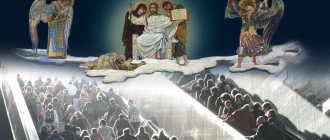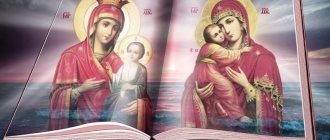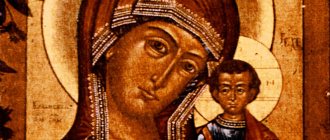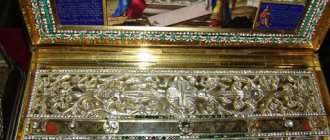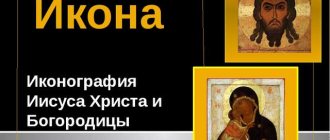Today, when we pronounce the word “Bible,” we all imagine approximately the same thing: a huge volume of a book with a large number of pages made of the thinnest paper, in which all the sacred texts of Christianity and Judaism are concentrated. And a lot of people think that it was like this all along, without wondering who wrote the Bible. However, the Book of Books did not immediately acquire its modern appearance. People have argued for centuries about what should be included in the sacred volume. The Bible is a book that has been reread for several millennia, carefully analyzing every sentence, word and every sign; people have accumulated many questions and contradictions that complicate an accurate comprehension of the sacred text.
The author of the book is the Lord God himself. And the people who write down his words here on earth are just his “co-authors.”
Old Testament, Books of Ezra
In what year was the Bible written? The complete list of books included in the Christian Old Testament, in Jewish Tanakh, were created around the 13th century BC. e.
In various lists and variations they were passed on to religious communities. There was no common opinion among Jewish theologians; some of them could consider the text sacred, while others could simply declare it apocryphal. Such disorganization was detrimental to the young religion. Many people could not understand the intricate interpretations and intricacies of the books of the Tanakh, so they decided to return to paganism, which is devoid of such problems.
The Jewish priests were very concerned about this problem. The man who undertook to restore order to the Holy Scriptures of the Jews was the first priest Ezra, who lived in the 5th century BC. e. In fact, he can be dubbed the “father” of Judaism. For the Christian people, he is the “father” of the Old Testament. Having collected the books, Ezra established which of them should be considered correct, and began to introduce the Law sent from above among the Jewish people.
Some editions of the Old Testament were created during the 5th century BC. e. to the 1st century after the Birth of Christ after the death of Ezra, such as the Maccabees books. These books are considered to be the “historical books” of the Bible due to the fact that they tell not so much about the relationship with God as about the traditions of the Jewish people. However, they are recognized as sacred.
The truth is that the same problems began with them as with ancient books. Namely: which of the texts is considered inspired by God, and which is simply thoughts about the history of the priest himself?
With these questions, the Jews decided only towards the end of the 1st century AD. At a meeting of the Sanhedrin, the Jewish canon was officially adopted. The meeting took place in the city of Yavne after the destruction by the Roman army of the main shrine of the Jews - the Temple of Jerusalem. The Tanakh consists of 22 (according to other sources - 24) books:
- the books of the prophets (Neviim) and the writings of the sages of Israel;
- prayer poetry (Ketuvim);
- as well as the Pentateuch of Moses (Torah).
What language is the Bible written in? Obviously in Hebrew.
Authenticity of Biblical Texts
The authenticity and antiquity of many Old Testament and New Testament texts is confirmed by archeology. In the mid-20th century, a sensational discovery was made in the Judean Desert near the Dead Sea. In the Qumran caves, 190 fragments of manuscripts with passages from the Holy Scriptures and other religious texts dating back to the 1st - 2nd centuries AD were found. This confirmed the antiquity of the Christian texts from a historical point of view.
What language is the Bible written in? The Old Testament is in Hebrew. Although in some places there are passages in Aramaic, Phoenician and other languages. But due to the fact that the originals were written on papyrus scrolls or parchment, which are very poorly preserved, the Bible has survived to this day mostly in copies and translations.
Most of the New Testament texts we now have are written in Greek.
List of holy books
A new religion arose in the 1st century - Christianity, which inherited problems from Judaism along with the Old Testament. Deciding what deserved to be transferred from the old faith to the new and what did not was very difficult. Christians previously became familiar with a large number of biblical books in Greek, and not in the original Hebrew. This introduced a certain amount of distortion and misunderstanding due to the nature of the translation.
As long as Christians lived in independent, scattered and secret societies, there was no talk of a canon. Each presbyter or deacon independently decided which books to read to his flock. The words of Jesus Christ meant more to them than their Jewish heritage. Christians decided to make a decision about the Old Testament only in the 7th century, after they had resolved the most difficult internal church disputes and defined the most important theological concepts.
In the future, the Eastern churches will be called Orthodox.
In 692, at the Trullo Council of the Eastern Churches, a decision was made to recognize 39 canonical books as sacred (those that were recognized by the Jews) and 11 non-canonical (those that, for various reasons, were rejected by the Sanhedrin). This list of 50 Old Testament books is still read in traditional Orthodox society.
However, the Bishop of Rome (who will become the head of the Catholic Church in the near future) refused to sign the conclusion of the Trullo Council. The thing is that among the decisions of the council there were condemnations of some customs that were accepted by the Western Church, but rejected by the Eastern. By refusing to sign the decisions of the council, the head of the Roman church also refused to approve the books that would be included in the Old Testament. Therefore, Catholics had to live without a canon until the 16th century.
At the Council of Trent only in 1546, a list was approved; it included 46 books. However, among the Eastern churches the agreement did not last long. Later, many of them revised the canon, which was adopted by the Trullo Council. Today, many of them have a very different list of books of the Old Testament. For example, the canon of the Ethiopian Orthodox Church includes 54 books.
In the 16th century, the emerging Protestants also thought about the canon of the Old Testament along with Catholics. Trying to cleanse Christianity of all unnecessary things, the reformers also approached the Jewish heritage very critically. Some followers of Martin Luther decided that those books preserved in the original language should be recognized as canonical. All the rest, which reached them only in Greek translations, can only claim the status of apocrypha. That is why there are only 39 books in the Protestant Old Testament.
Regarding the New Testament, the followers of Jesus Christ agreed in the most organized way. It included 27 books, recognizing almost all Christian denominations, with rare exceptions. Such as the Acts of the Apostles, the four Gospels, the 21 Epistles of the Apostles and the Revelation of John the Theologian.
Thus, it turns out that the Orthodox Bible contains 77 books, the Catholic Bible has 73 books, and the Protestant Bible has 66 books.
Bible meaning
Who wrote the Bible (from the Greek for “book”) and what is it? These are 77 books written in different historical eras, combined into one. 50 books of the Old Testament (39 canonical and 11 non-canonical), 27 of the New Testament.
The Bible is unique; it contains all the main literary subjects, all genres of literature. And the question of the authorship of the books of the Bible has always occupied both secular scientists and ordinary believers. The study of any literary work begins with getting to know the author, the era in which he lived and worked. From a Christian point of view, the Bible has one Author - God, but these books were written by people. It is important for Christians to understand who these people were through whom God revealed His will to humanity.
Bible
Who wrote the Old Testament
Having decided on the composition of the Holy Scriptures, we can return to the question of authorship.
This problem is primarily directly related to the Pentateuch (Genesis, Exodus, Numbers, Leviticus, Deuteronomy), which contains the most important postulates of belief in One God. These included the Ten Commandments; Jewish and then Christian morality were based on them. For a long time, the fact that these books were written personally by the prophet Moses was not questioned. The only deviation from this interpretation, allowed by the rigid early Jewish priests, is that the last 8 verses of Deuteronomy, which tell about the death of Moses, were written by Joshua. Some Pharisees still insisted that these lines were written by Moses himself, to whom a revelation was sent about how he would end his last days.
However, the more carefully and longer the Christian and Jewish scribes read the Pentateuch, the clearer the contradictions that existed in it became. For example, in the list of kings who ruled the people of Judah, those who lived after the death of Moses are also mentioned. This can also be explained by divine providence. However, why certain stories are narrated twice in the Pentateuch, with obvious discrepancies, is more difficult to explain.
Still, the fear of being accused of blasphemy was too strong. Only in the 18th century did the German Johann Eichhorn and the Frenchman Jean Astruc propose the version that the Pentateuch is a mixture of two primary sources together. They proposed to distinguish them by the name of God. In the first case he is called Yahweh, and in others he is called Elohim. In this regard, the sources acquired the names Elohist and Yahwist.
In the 19th century, this theory was developed by other researchers who suggested that the number of primary sources was greater. Current biblical scholarship believes that there are at least 4 sources in the Pentateuch.
A similar story happened with the books of the prophets Ezekiel and Isaiah. Based on the textual analysis of the Song of Solomon, we can conclude that it was most likely written in the 3rd century BC. e. Thus, 700 years later than the times when King Solomon was still alive.
Read this article: Prayer Creed. You might be interested...
Part III
In paradise, the harmony of human freedom and Divine grace could become a luminous bridge over that “infinite distance” that, as John of Damascus says, separates the creature from the Creator. Adam was directly called to deification. But after the Fall, two obstacles arise that make this distance insurmountable: sin itself, which deprives human nature of the ability to perceive grace, and death - the completion of the fall, plunging humanity into an unnatural state, when the willfulness of man, having infected the entire cosmos, imparts a paradoxical and tragic nature to non-existence. reality.
In this state, a person can no longer remain at the level of his calling. But the Divine plan has not changed: God still wants man to unite with Him and transform the whole earth.
The ultimate and entirely positive goal of man acquires from this moment a negative aspect - the aspect of salvation. In order for a person to freely return to God, it is necessary for God to first free him from the state of guilt and death. This state requires redemption, which, in the totality of the Divine plan, thus appears before us not as an end, but as a negative means. After all, only one who is a helpless prey to evil can be saved.
The history of mankind after the Fall is the history of a long shipwreck with the expectation of salvation. But the haven of salvation is not yet the goal; it gives the castaway the opportunity to set out again on the journey towards the only – still the same – goal: unity with God. So, after the loss of the heavenly state, a person can no longer objectively achieve his ultimate goal. In the new state of nothingness and death, he is in a position of painful passivity; at first it is an inextinguishable, aching longing for paradise, and then an increasingly conscious expectation of salvation. The movement of the fall continues, which is why, firstly, the expectation becomes more and more sorrowful, and, secondly, either countless ways are born to forget (try to forget) about death, that is, about separation from God, or the Luciferian aspiration of the will to save yourself and self-deification. But both “angelism” and “Babylonism” are defeated, and people do not stop waiting for Someone who would come to save them. So, the whole history of mankind is the history of salvation, in which we can distinguish three periods.
The first period is a long preparation for the coming of the Savior: it lasts from the Fall to the Annunciation: “The day of our salvation is chief,” the Church sings on this holiday. Throughout this entire period, Providence constantly takes into account the will of people and, in accordance with this, chooses its instruments.
The second period, from the Annunciation to Pentecost, corresponds to the earthly life and ascension of Christ. Here man cannot do anything: Christ alone, with His life, resurrection and ascension, accomplishes the work of salvation. In His Person humanity and Divinity are united, eternity enters time, time penetrates eternity, deified anthropocosmic nature is introduced into Divine life, into the very bosom of the Most Holy Trinity.
And now, with Pentecost, a new period begins when human individuals, with the assistance of the Holy Spirit, must freely acquire the deification that their nature once and for all acquired in Christ. In the Church, freedom and grace cooperate. Out of respect for human freedom, God allows the time of sin and death to continue: He does not want to force Himself on man, but wants a response of faith and love from him. Our position, however, is incomparably superior to the heavenly state: we are indeed no longer at risk of losing grace, we can always participate in the Theanthropic fullness of the Church. The very conditions of our weakness, which Christ took upon Himself entirely, are revealed through repentance and faith towards the mystery of love. So, the history of the Church is the free awareness by people of the unity perfect in Christ and always present in the Church, where the eternal radiance of the Kingdom has already been granted. In this way we will work towards the complete destruction of death and the transformation of the cosmos, in other words, the second coming of the Lord.
* * *
The period of preparation is the promise: a slow progress towards Christ, during which the Divine “pedagogy” wants to make possible the fulfillment of the promise given at the very moment of punishment.
The Old Testament did not know internal sanctification by grace, and yet it knew holiness, because grace, acting from the outside, evoked it in the soul as a certain fruit of this influence. A person who, by faith, remains in obedience to God and lives righteously, could become an instrument of His will. As the calling of the prophets testifies, this was not the agreement of two wills, but the authoritative use of the will of the Divine human will: the Spirit of God fell upon the one who knew how to see, God took possession of man from the outside, imposing His demands on his personality. The invisible God spoke, His servant listened. The darkness of Sinai was opposed to the light of Tabor, like a hidden secret to an revealed secret. Through obedience and purity a man prepared himself in the darkness of faith for service. Obedience and purity are negative concepts: they presuppose the manifestation of God from without and the submission of man, who becomes His instrument, a man who, even being righteous, cannot free himself from his state of sinfulness and mortality. Holiness as the active sanctification of the entire being and the free assimilation of human nature to the nature of God can only manifest itself after the feat of Christ - in the consciousness of this feat. Therefore, the main thing in the Old Testament is the law; The relationship between God and man here is not unity, but a union, the guarantee of which is fidelity to the law.
The history of the Old Testament is a history of elections associated with subsequent falls. Throughout this history, God saves a certain “remnant”, the expectation of which reaches ever greater purity: in the very dialectic of disappointments, the expectation of the victorious Messiah turns into the expectation of the suffering servant of Jehovah, the expectation of the political liberation of one people into the expectation of the spiritual liberation of all humanity. The more God moves away, the deeper man’s prayer becomes; the more limited the chosenness, the broader the goal - right up to the all-surpassing purity of the Virgin, capable of giving birth to the Savior of all mankind.
The first fall after the loss of paradise was the murder of Abel by Cain. God told Cain:
“Does not sin lie at your door? He attracts you to himself, but you dominate him.”
But Cain killed his brother. This first fall corresponds to the first election: the election of Seth and his descendants. The sons of Seth are “sons of God”, they call on the name of Jehovah and one of them, Enoch, “walked with God” and was; perhaps he was taken by God to heaven with his body. The descendants of Cain, on the contrary, are only sons of men, tragically doomed to death (
“I killed a man for my wound and a boy for my wound”
, says Lamech). Cursed by the cultivated land, which absorbed the blood of Abel, they become the first townspeople, inventors of technology and art. With them comes civilization - this huge attempt to make up for the absence of God. People try to forget God or replace Him: to forget in the forging of metals, surrendering themselves to the captivity of earthly heaviness and the impenetrable power it imparts, like Tubalcain, the father of all forgers.
"tools of copper and iron"
(Gen. 4:22), or replace It with a festival of art, the languid consolation of music, like Jubal, the father
"all those who play the harp and flute"
(Gen. 4:21). Art appears here as a cultural value, not a cult value; This is a prayer that reaches nowhere, because it is not addressed to God. The beauty generated by art closes in on itself and with its magic rivets a person to itself. These inventions of the human spirit lay the foundation for culture, as a cult of some abstraction in which there is no One Present to Whom every cult should be addressed...
The flood comes, and it seems that God is returning to the primeval waters his creation, distorted by the fall. Perhaps this new fall should be associated with mysterious communication between angels and people, as a result of which “giants” appear (Genesis 6: 1–4). Was this not some kind of Luciferian gnosis from which man drew unusual power? But be that as it may, a certain “remnant” - one person and his loved ones - found favor in the eyes of God, because
“Noah was a righteous man and blameless in his generation; Noah walked with God"
(Gen. 6, 9). Noah saves humanity and all earthly creation, not by regenerating them, like Christ - he is only His prototype - but by ensuring the continuation of their existence. After the flood, God enters into a cosmic alliance with humanity that stabilizes the earthly universe; the sign of this covenant becomes a rainbow, a mysterious, luminous bridge connecting heaven and earth.
A new fall occurs with the construction of the Tower of Babel. The Tower of Babel is a usurping impulse of a godless civilization, only human unity in its purely earthly desire to conquer heaven. This is how eastern sacred civilizations erected their ziggurats, these temples, the floors of which symbolized, apparently, those internal steps along which the initiate had to methodically ascend. The Tower of Babel is typical of these archaic examples, but also superior to them; it is still relevant today.
Unity without God entails a just punishment: dispersion away from God. Then multilingualism and chaos of “nations” are born. But God uses even evil itself, responding to the fall with election, and from these nations, formed among divisions and confusions, He chooses as His instrument one people, the Jewish people, who received their name from Eber, one of the descendants of Shem. This election culminates in union with Abraham; an election this time historical, in which the glory of a descendant more numerous than the stars of heaven is proclaimed. But Abraham must be tested in his very hope so that it can be completely fulfilled. The sacrifice presented to him - the heir of the promise, Isaac - requires faith beyond all logic, unconditional obedience. While climbing Mount Moriah, Abraham answers Isaac's question: “God will provide for Himself a lamb for a burnt offering, my son.” And when at the last moment God actually replaces the human sacrifice with a ram, we understand that every time a person is obedient, God is preparing the Divine Lamb - Christ. Can He not give His Own Son when a man gives his own? So, the history of the Old Testament is not only the history of prototypes of salvation, but also the history of man’s refusals and consents. Salvation approaches or moves away depending on whether a person is ready or not ready to accept it. Καιρος of Christ, His “time” depends, therefore, on human will. The whole point of the Old Testament lies in these fluctuations, which emphasize the double aspect of Providence. Providence is not one-sided, It takes into account the expectation and call of man. Divine pedagogy subjects a person to a test and tests his intentions.
This test is sometimes also a struggle, for God wants man’s freedom not only to be able to resist Him, but also to force Him, if not to reveal His name, then at least to bless: thus Jacob becomes Israel,
“For you have wrestled with God, and you will overcome men”
(Gen. 32, 28).
And the patriarch becomes the people, and when this people is captured by Egypt, God raises up Moses to liberate them. On Mount Sinai, God passes in His glory before Moses, but does not allow him to see His Face,
“for man cannot see Me and not die”
; The divine nature remains hidden. But the election of Israel - and this is the decisive stage - is confirmed by a new union: the law. The law—the written obligations to which the chosen people must obey—is accompanied by divine promises, which are continually refined by the prophets. Thus the law and the prophets complement each other, and Christ always mentions them at the same time when he emphasizes their accomplishment. Prophets are people chosen by God to proclaim the deeper meaning of the law. To the Pharisees, who gradually turned the law into some kind of static reality and means of justification, the prophets explained its spirit, its historical dynamism and the eschatological call contained in it, forcing man to realize his sin and his powerlessness before it.
Thus, the meaning of the prophets for the chosen people is similar to the meaning of Tradition for the Church: and indeed, both the prophets and Tradition reveal to us the true meaning of Holy Scripture. This duality - the law and the prophets - already expresses in some way the final action of the Logos and the life-giving action of the Spirit. In the Old Testament, the spirit of prophecy clearly reveals to us the action of the third Person of the Most Holy Trinity. The circle of election is slowly narrowing: in Israel - the tribe of Judah, in the tribe of Judah - the house of David. This is how the tree of Jesus grows until the final and highest election of the Most Pure Virgin.
This election was announced to Mary by the Archangel Gabriel. But Mary could freely agree or refuse. The entire history of the world, the entire accomplishment of Divine vision depended on this free response of man. The Virgin's humble consent allowed the Word to become flesh.
“Behold the handmaid of the Lord, let it be done to me according to your word.”
(Luke 1:38). Everything that God expected from fallen humanity was realized in Mary: personal freedom finally revealed its human nature, its flesh for the necessary work of salvation. The Second Person of the Most Holy Trinity was able to enter history without powerfully invading it, for then man would have remained only an instrument, without singling out the Virgin, for then She would have been separated from the descendants of Adam, but through that agreement with which centuries-old Divine pedagogy was finally rewarded. Precisely because God, with all the determination, with all the respect inherent in His love, took upon Himself the work of human salvation, the Most Pure Virgin, in Whom all Old Testament holiness was “perfected,” was able to offer this love the pure receptacle of Her flesh. Her ancestors, blessed by God and purified by the law, received the word of the Word in the Spirit. She was able to contain the Word Itself bodily. Having given birth to the Divine Person Who accepted Her humanity, She truly became the Mother of God. And therefore Saint John of Damascus could say: “The name “Theotokos” (Φεοτοκος) contains the entire history of the Divine economy in the world.” But Old Testament holiness not only gave the Word His Mother, and, one might say, a Bride; This holiness prophetically pointed to Him for Israel: Mary is the embodiment of silence. John the Baptist, who came in the spirit of Elijah, is a voice crying in the wilderness, the last prophet who recognized and pointed with his finger
"The Lamb who takes away the sins of the world."
The Old Testament reaches its conclusion in these two human beings, whom the iconography venerates, placing on either side Christ the Glorified Bride and the Friend of the Bridegroom.
Who wrote the New Testament
New Testament scholars have just as many questions. The more detailed they reread the canon of Gospels, the more often the question arose: how much was actually written by Jesus’ companions - the apostles? None of the gospel texts (the exception is the Gospel of John) contains a description of the author’s personality. So perhaps we only have the retellings that were written down by those who studied with the apostles and would like to preserve and record their stories for posterity?
The peculiarities of the style in which these texts were written pushed a large number of theologians to the idea that they could not have been created earlier than the second half of the 1st century. In the modern world, biblical scholars fully agree that the Gospels were written by anonymous authors who had the stories of the apostles themselves at their disposal, as well as some text that has not survived to this day, scientists nicknamed it “Source 0”. This source was not a gospel story, but rather was a semblance of a collection of Jesus’ words, which were most likely recorded by direct listeners of his sermons.
The general consensus among Bible scholars is that Mark was the first gospel to be written. This was around the 60s and 70s. Next, on its basis, the Gospels of Matthew (70-90s) and Luke (80-100s) were written. Actually, that’s why the texts of all these stories are so close. The Gospel of John was created around 80-95 and was written apart from everyone. In addition, the author of the Gospel of Luke was most likely the author of the Acts of the Apostles. Later, instead of the names of the authors, “holy authors” were added.
Jewish collection Tanakh
The Tanakh is the combined records of the Torah (Law), Nevi'im (Prophets), and Ketubim (Scripture). According to many researchers, these sacred texts began to be put together during the time of King Solomon, and were completed a couple of centuries before the birth of Jesus Christ. It is believed that this work was carried out by Ezra and his assistants. However, nothing is known about this for certain.
Version canonized in Europe
Unlike Ancient Rus', in Europe there was a long debate about which translation of the Tanakh should be considered canonized. The Jewish canon itself did not include the Apocrypha. The Catholic Old Testament that existed at that time consisted of several books. As a result, the translation made from the Masoretic Hebrew text in 1611 (commissioned by the King James) becomes the official version in Great Britain. Forty-seven scientists from different universities carried out this work. During the process, they often worked separately and then compared the results. In controversial cases, decisions were made by majority vote. To date, many errors have been found in this translation. In addition, the work was carried out under some pressure from the King James, who recommended that scholars emphasize “the King’s divinely given right to rule.”
There are other scriptures canonized by the Catholic Church. Thanks to the information preserved in them, it is almost always possible to explain the ambiguities of the Old Testament of the King James.



